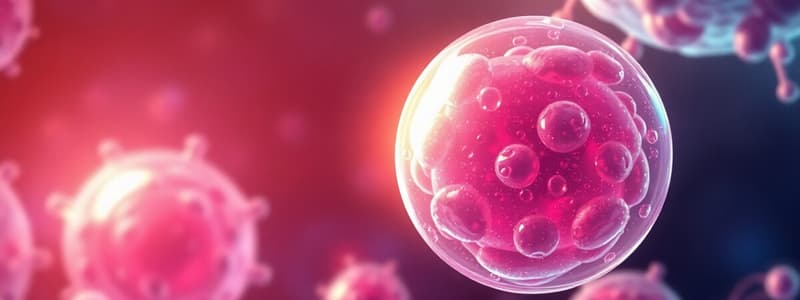Podcast
Questions and Answers
Which of the following is the primary benefit of compartmentalization in eukaryotic cells?
Which of the following is the primary benefit of compartmentalization in eukaryotic cells?
- It prevents the synthesis of proteins within the cell.
- It sequesters incompatible reactions, allowing specialized functions to occur without disrupting other cellular processes. (correct)
- It ensures that all cellular processes occur at the same pH level.
- It allows prokaryotic cells to perform specialized functions more efficiently.
In eukaryotic cells, what advantage does the presence of a nucleus provide over prokaryotic cells?
In eukaryotic cells, what advantage does the presence of a nucleus provide over prokaryotic cells?
- It protects DNA and allows for modification of mRNA before translation. (correct)
- It allows simultaneous transcription and translation.
- It eliminates the need for ribosomes.
- It facilitates faster protein synthesis.
Which of the following characteristics distinguishes organelles from other cellular components?
Which of the following characteristics distinguishes organelles from other cellular components?
- Organelles are typically large and complex structures.
- Organelles occupy a discrete space within the cell and perform specific tasks. (correct)
- Organelles are responsible for the breakdown of the cell's structural components.
- Organelles are always bound by a single membrane.
Why is the ability to alter the pH within a vacuole without affecting the chemistry of the cytoplasm advantageous to the cell?
Why is the ability to alter the pH within a vacuole without affecting the chemistry of the cytoplasm advantageous to the cell?
What is the primary function of lysosomes, and how does compartmentalization assist in this function?
What is the primary function of lysosomes, and how does compartmentalization assist in this function?
Which of the following is NOT considered an organelle within a cell?
Which of the following is NOT considered an organelle within a cell?
How does the structure of mitochondria contribute to its function within eukaryotic cells?
How does the structure of mitochondria contribute to its function within eukaryotic cells?
A cell intakes an external component. Which organelle is directly involved in enclosing this component?
A cell intakes an external component. Which organelle is directly involved in enclosing this component?
Which of the following best illustrates the relationship between organelles and cellular function?
Which of the following best illustrates the relationship between organelles and cellular function?
Which of the following is an example of a non-membrane bound organelle?
Which of the following is an example of a non-membrane bound organelle?
Flashcards
What are organelles?
What are organelles?
Structures within cells that perform specific tasks.
Eukaryotic cells: Key feature
Eukaryotic cells: Key feature
Compartmentalized due to membrane-bound organelles.
Organelle membrane types?
Organelle membrane types?
Double-membrane bound (mitochondria) or non-membrane bound (centrioles).
Advantage of the nucleus?
Advantage of the nucleus?
Signup and view all the flashcards
mRNA processing: Where?
mRNA processing: Where?
Signup and view all the flashcards
Advantage of compartmentalization?
Advantage of compartmentalization?
Signup and view all the flashcards
What do lysosomes contain?
What do lysosomes contain?
Signup and view all the flashcards
Why are enzymes in lysosomes contained?
Why are enzymes in lysosomes contained?
Signup and view all the flashcards
Phagocytosis leads to...
Phagocytosis leads to...
Signup and view all the flashcards
pH in vacuoles...
pH in vacuoles...
Signup and view all the flashcards
Study Notes
- Organelles are structures within cells that perform specific tasks.
- Eukaryotic cells are compartmentalized due to their membrane-bound organelles.
- Organelles can be double-membrane bound (mitochondria) or non-membrane bound (centrioles).
Examples of Organelles
- Nucleus
- Vesicles
- Ribosomes
- Plasma membrane
Non-Organelles
- Plant cell wall
- Cytoplasm
- Cytoskeleton
- These are not organelles because they don't occupy a discrete space or are too large/complex.
Advantages of Nucleus
- Eukaryotic cells protect and manage DNA within the nucleus, unlike prokaryotic cells.
- In prokaryotic cells, transcription and translation occur in the same space, allowing immediate translation.
- In eukaryotic cells, mRNA must exit the nucleus for translation, allowing modification of the mRNA sequence.
Advantages of Compartmentalization
- Eukaryotic cells have organelles separated by membranes within the cytoplasm.
- Cells can perform specific tasks within organelles without impacting the rest of the cell.
- Lysosomes contain digestive enzymes to break down macromolecules.
- Keeping enzymes within a membrane prevents them from damaging other parts of the cell.
- Cells can intake external components via phagocytosis and place them within a vacuole.
- Enzymes within vacuoles work at different pH levels.
- Altering the pH within a vacuole does not affect the chemistry of the cytoplasm.
Studying That Suits You
Use AI to generate personalized quizzes and flashcards to suit your learning preferences.




